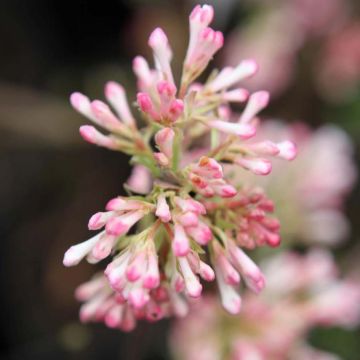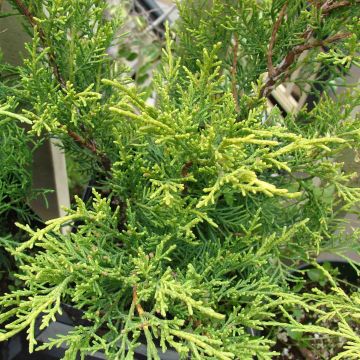

Syringa vulgaris Znamya Lenina - Common Lilac


Syringa vulgaris Znamya Lenina - Common Lilac
Syringa vulgaris Znamya Lenina - Common Lilac
Syringa vulgaris Znamya Lenina
Common Lilac, Lilac
Special offer!
Receive a €20 voucher for any order over €90 (excluding delivery costs, credit notes, and plastic-free options)!
1- Add your favorite plants to your cart.
2- Once you have reached €90, confirm your order (you can even choose the delivery date!).
3- As soon as your order is shipped, you will receive an email containing your voucher code, valid for 3 months (90 days).
Your voucher is unique and can only be used once, for any order with a minimum value of €20, excluding delivery costs.
Can be combined with other current offers, non-divisible and non-refundable.
Home or relay delivery (depending on size and destination)
Schedule delivery date,
and select date in basket
This plant carries a 24 months recovery warranty
More information
We guarantee the quality of our plants for a full growing cycle, and will replace at our expense any plant that fails to recover under normal climatic and planting conditions.
Would this plant suit my garden?
Set up your Plantfit profile →
Description
The Lilac 'Znamia Lenina', born in Russia, is a particularly flowerful and colourful variety from the Syringa vulgaris, the common lilac. Its clusters of single flowers, long, thin and erect, bloom profusely in the spring, in an unusual raspberry colour, intermediate between purple red and dark pink, with a hint of violet. Its vigour allows it to settle in a large flowering hedge, or a cluster of rustic bushes. A deciduous, easy and generous bush, which should be present in every garden, regardless of its style and pruning. Its clusters of very fragrant flowers are wonderful in flower bouquets
Fallen out of use in the 1960s-1970s following the discovery of the American or Asian lilacs, the European lilac and its hybrids, larger, are making a strong comeback in our gardens, like the old roses which were reproached for their single flowering, and were therefore neglected in favour of modern hybrids.
The Syringa vulgaris 'Znamia Lenina', so named in 1936 in honour of Lenin by its creator Kolesnikov, is a bush of the oleaceae family still present in gardens and nurseries' catalogues. It is often forgotten that the common lilac, also known as European Lilac, is actually native to Southeast Europe and Western Asia, more precisely the Balkan peninsula, and only arrived in Western Europe at the end of the Renaissance. In nature, this untameable plant with very fragrant bluish-violet-purple flowers colonises the rocky hills and braves cold winters.
The variety 'Znamia Lenina' forms a bush with an erect and rounded habit, reaching a height of up to 4 m (13 ft 1 in) (most often 3.50 m (11 ft 6 in)) and a spread of 2.50 m, on average. It spontaneously forms a bush composed of multiple stems, like the philadelphus with which it should not be confused. Its leaves, deciduous, triangular and heart-shaped, 4 to 12 cm (1.6 to 4.7 in) long and 3 to 8 cm (1.2 to 3.1 in) wide, appear in the spring, in a fairly dark green shade, with a satin finish. The flowering takes place in May or sometimes from April 15th depending on the climate. At the end of the one-year-old branches appear long ramified clusters grouped in pairs, or even more. These compound clusters, called thyrsus, sometimes reach 25 cm (9.8 in) in length. Their shape, generally pyramidal, is rather slim. The deep purple-red flower buds bloom into single flowers, with four petals, the corolla forming a long tube at the base. Their red-pink-violet colour is both rich and intense. They emit a pronounced, very floral fragrance.
Easy to grow in any drained soil, under almost all our climates, the Common Lilac 'Znamia Lenina' is a must-have bush in a flower garden or an old-fashioned one. Use it, mixed with other white, mauve, pink or red varieties, abundantly, in large flowering hedges, in company of single-flowered roses, philadelphus, or amelanchiers. A hedge of lilacs, flowering Prunus, Almond tree of China, Japanese quinces and ornamental apple trees, planted overlooking a sunken alley, is a real delight in spring. It can also be used alone, surrounded by a bed of ground-cover roses, in a small dedicated space, to make this modest subject a grandiose bush, covered in glory at the heart of spring.
Report an error about the product description
Syringa vulgaris Znamya Lenina - Common Lilac in pictures






Plant habit
Flowering
Foliage
Botanical data
Syringa
vulgaris
Znamya Lenina
Oleaceae
Common Lilac, Lilac
Cultivar or hybrid
Planting and care
The common Lilac Znamya Lenina enjoys being planted in full sun, in soil that remains quite fresh, deep, even clay-limestone. It tolerates all types of soil, but prefers slightly limestone ground and fears highly acidic soils. It will grow well in semi-shaded exposure, but the flowering will be reduced. Its hardiness is excellent, beyond -15 °C. Easy to grow, it only requires mulching and regular watering in summer in a dry climate, to maintain a certain humidity. While the common lilac grows happily in the south of our country, its large-flowered hybrids suffer from the lack of water that disfigures their thirsty vegetation. In all cases, water it in the first years in case of marked drought. You can prune the flowering shoots to make beautiful bouquets, or at the end of flowering to encourage the appearance of new flowers and avoid tiring the bush. Avoid severe prunings that limit the flowering of the following spring, unless your Lilac is getting too big.
Planting period
Intended location
Care
This item has not been reviewed yet - be the first to leave a review about it.
Similar products
Haven't found what you were looking for?
Hardiness is the lowest winter temperature a plant can endure without suffering serious damage or even dying. However, hardiness is affected by location (a sheltered area, such as a patio), protection (winter cover) and soil type (hardiness is improved by well-drained soil).

Photo Sharing Terms & Conditions
In order to encourage gardeners to interact and share their experiences, Promesse de fleurs offers various media enabling content to be uploaded onto its Site - in particular via the ‘Photo sharing’ module.
The User agrees to refrain from:
- Posting any content that is illegal, prejudicial, insulting, racist, inciteful to hatred, revisionist, contrary to public decency, that infringes on privacy or on the privacy rights of third parties, in particular the publicity rights of persons and goods, intellectual property rights, or the right to privacy.
- Submitting content on behalf of a third party;
- Impersonate the identity of a third party and/or publish any personal information about a third party;
In general, the User undertakes to refrain from any unethical behaviour.
All Content (in particular text, comments, files, images, photos, videos, creative works, etc.), which may be subject to property or intellectual property rights, image or other private rights, shall remain the property of the User, subject to the limited rights granted by the terms of the licence granted by Promesse de fleurs as stated below. Users are at liberty to publish or not to publish such Content on the Site, notably via the ‘Photo Sharing’ facility, and accept that this Content shall be made public and freely accessible, notably on the Internet.
Users further acknowledge, undertake to have ,and guarantee that they hold all necessary rights and permissions to publish such material on the Site, in particular with regard to the legislation in force pertaining to any privacy, property, intellectual property, image, or contractual rights, or rights of any other nature. By publishing such Content on the Site, Users acknowledge accepting full liability as publishers of the Content within the meaning of the law, and grant Promesse de fleurs, free of charge, an inclusive, worldwide licence for the said Content for the entire duration of its publication, including all reproduction, representation, up/downloading, displaying, performing, transmission, and storage rights.
Users also grant permission for their name to be linked to the Content and accept that this link may not always be made available.
By engaging in posting material, Users consent to their Content becoming automatically accessible on the Internet, in particular on other sites and/or blogs and/or web pages of the Promesse de fleurs site, including in particular social pages and the Promesse de fleurs catalogue.
Users may secure the removal of entrusted content free of charge by issuing a simple request via our contact form.
The flowering period indicated on our website applies to countries and regions located in USDA zone 8 (France, the United Kingdom, Ireland, the Netherlands, etc.)
It will vary according to where you live:
- In zones 9 to 10 (Italy, Spain, Greece, etc.), flowering will occur about 2 to 4 weeks earlier.
- In zones 6 to 7 (Germany, Poland, Slovenia, and lower mountainous regions), flowering will be delayed by 2 to 3 weeks.
- In zone 5 (Central Europe, Scandinavia), blooming will be delayed by 3 to 5 weeks.
In temperate climates, pruning of spring-flowering shrubs (forsythia, spireas, etc.) should be done just after flowering.
Pruning of summer-flowering shrubs (Indian Lilac, Perovskia, etc.) can be done in winter or spring.
In cold regions as well as with frost-sensitive plants, avoid pruning too early when severe frosts may still occur.
The planting period indicated on our website applies to countries and regions located in USDA zone 8 (France, United Kingdom, Ireland, Netherlands).
It will vary according to where you live:
- In Mediterranean zones (Marseille, Madrid, Milan, etc.), autumn and winter are the best planting periods.
- In continental zones (Strasbourg, Munich, Vienna, etc.), delay planting by 2 to 3 weeks in spring and bring it forward by 2 to 4 weeks in autumn.
- In mountainous regions (the Alps, Pyrenees, Carpathians, etc.), it is best to plant in late spring (May-June) or late summer (August-September).
The harvesting period indicated on our website applies to countries and regions in USDA zone 8 (France, England, Ireland, the Netherlands).
In colder areas (Scandinavia, Poland, Austria...) fruit and vegetable harvests are likely to be delayed by 3-4 weeks.
In warmer areas (Italy, Spain, Greece, etc.), harvesting will probably take place earlier, depending on weather conditions.
The sowing periods indicated on our website apply to countries and regions within USDA Zone 8 (France, UK, Ireland, Netherlands).
In colder areas (Scandinavia, Poland, Austria...), delay any outdoor sowing by 3-4 weeks, or sow under glass.
In warmer climes (Italy, Spain, Greece, etc.), bring outdoor sowing forward by a few weeks.








































